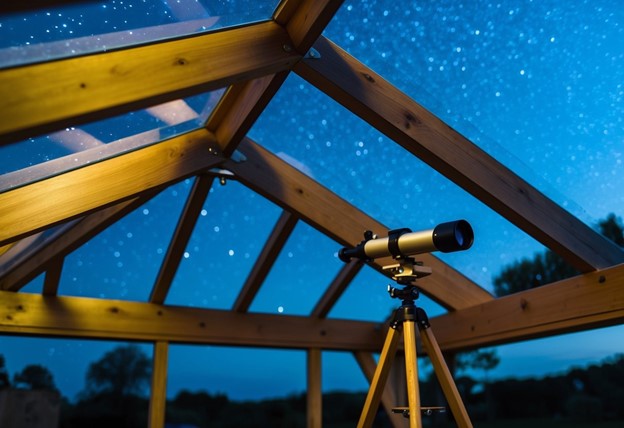How to Build a Roof for Stargazing with Kids
Embarking on a stargazing adventure with kids can be an exciting and educational experience. Building a dedicated space for night sky exploration adds an element of magic and fosters a lifelong appreciation for astronomy. Creating a simple roll-off roof structure provides an accessible way for families to observe the stars together.
Begin by choosing the right location, ideally a spot with minimal light pollution and an unobstructed view of the sky. Gathering appropriate materials is essential to ensure the stability and functionality of the roof. Using easy-to-follow designs can simplify the process and make it enjoyable for everyone involved.
Having an equipped space enhances the stargazing experience by allowing for the convenient setup of telescopes and other gear. Integrating educational resources and activities engages children’s curiosity, making each session memorable and informative. Share this unique experience and inspire a deeper interest in the wonders of the universe.
Understanding Basic Roof Construction
Building a roof for stargazing involves selecting appropriate materials and ensuring safety, especially when kids are involved. This requires attention to detail to ensure that the structure is stable, secure, and family-friendly.
Choosing the Right Building Materials
Selecting suitable materials is crucial for constructing a durable and effective stargazing roof. Wood, metal, and polycarbonate are common materials used for roof construction.
Pinnacle Home Improvements tells us that wood is often preferred for its aesthetic and insulating properties but may require protection from weathering. Metal roofs, such as those made from aluminum or steel, offer durability and strength, with excellent resistance to various weather conditions. Meanwhile, polycarbonate is lightweight and allows light passage, making it an excellent option for certain designs.
Materials should also be easy to source and manage, especially when engaging young helpers. Considering the local climate will help in deciding whether more insulation or waterproofing might be necessary. Ensuring compatibility between materials used for the frame and the roof itself can prevent future issues.
Safety Considerations for Families
Safety is a top priority when building a roof suitable for families, especially with children involved in the project. Protective gear like helmets and gloves should be worn by all participants to minimize potential injuries.
Construction should focus on creating a structure without sharp edges or unstable parts. Weatherstripping extensions and covered nails can prevent injuries from unforeseen protrusions. Additionally, the foundation must be secure to support both kids and adults. Clear, simple instructions are vital when involving young family members, and tasks should be age-appropriate to maintain safety without sacrificing involvement.
Regular maintenance checks can identify and rectify any hazards promptly. Consider incorporating child-proof locks or security measures on areas that should remain off-limits when unsupervised.
Designing a Stargazing Roof with Kids

When creating a stargazing roof with kids, it’s important to consider their safety and engagement. Incorporating features that are both functional and exciting can transform the experience into a memorable learning opportunity. Selecting a theme can spark interest and further enhance the joy of stargazing.
Incorporating Child-Friendly Features
Designing a safe and fun environment is crucial when building a stargazing roof with children. Safety rails can be installed to prevent falls, and non-slip surfaces help reduce the risk of accidents. It’s advisable to use soft cushioning materials in areas where children might sit or lean.
Interactive elements like easy-to-read star charts or rotating panels with constellations can make observation sessions engaging. Providing simple telescopes designed for children encourages active participation and learning. These features ensure that the roof not only fits the purpose of stargazing but is also a secure and enjoyable space for young explorers.
Selecting a Theme for Engagement
Choosing a theme can significantly enhance a child’s interest in stargazing. A space-themed design with glow-in-the-dark stars on the roof can make the experience magical. Themes inspired by popular space-related cartoons or movies could also resonate well with younger audiences.
Themed decorations and accessories, such as planet models or galaxy murals, add an educational element. Including a storytelling corner with books about space adventures can inspire curiosity and creativity. Creating a narrative can turn stargazing into a captivating journey, encouraging children to learn while having fun.
By tailoring the roof design to accommodate these elements, the experience becomes both educational and enjoyable.
Building the Stargazing Roof
Creating a stargazing roof that is safe and functional involves understanding the construction site preparation and following a detailed building process. This ensures a sturdy structure suitable for both small and large telescopes.
Preparing the Construction Site
Before starting construction, selecting the right location is crucial. The site should be clear of obstructions like tall trees or buildings to provide an unobstructed view of the sky. Ensuring the ground is level is essential to maintain the stability of the roof.
The foundation requires careful planning. Digging about 1-2 feet deep and adding a gravel base for drainage is recommended to prevent moisture damage. Using thick-treated lumber or concrete can provide a durable and stable base. It helps to verify that the ground is level with high-quality tools such as a spirit level.
Step-by-Step Construction Process
Creating the frame involves precise measurements and materials. Many builders use 2x4s for framing, while larger beams like 2x6s can support additional weight. For a roll-off roof design, consider using a 2×6 cross beam and additional supports such as angle braces to ensure stability.
Establishing an easy-to-operate roof mechanism, such as sliding rails or hinges, can simplify the process of opening and closing the roof. Weatherproofing materials protect the interior and keep equipment safe from the elements. Ensuring clean alignments during the build will improve both the roof’s functionality and longevity.
Enjoying Your New Stargazing Roof
A stargazing roof offers families a special place to explore the night sky. To make the most of this experience, it’s important to plan engaging activities and maintain the space effectively over time.
Organizing a Family Stargazing Night
To create a memorable stargazing night with your family, consider setting up a schedule to identify key celestial events like meteor showers or planet alignments. Websites and astronomy apps can help in planning these events.
Gather necessary equipment such as a telescope or binoculars. Comfort items like blankets, pillows, and seating can enhance the experience. Keep snacks and drinks handy to make the outing relaxing and enjoyable. Use these opportunities to teach children about the stars, planets, and other celestial bodies.
To engage everyone, prepare a list of constellations or stars to find. Turning this into a friendly competition can make the night both educational and fun. Encourage children to ask questions and share what they see.
Maintenance and Upkeep Tips
Maintaining your stargazing roof ensures it remains a safe and enjoyable space. Regularly check for loose or damaged materials, particularly if the roof has moving parts like a roll-off structure. Ensuring that the roof remains watertight and weather-resistant is crucial to protect both the structure and any equipment stored there.
Frequently clean the space to remove debris that may have accumulated and inspect equipment like telescopes and binoculars. Ensure they are stored in a secure, weatherproof location to prevent damage.
Involving the whole family in maintenance tasks teaches responsibility and makes caring for the stargazing area a shared activity. Keep a checklist of maintenance tasks and schedule regular times to address them, making upkeep a routine part of your stargazing adventures.




